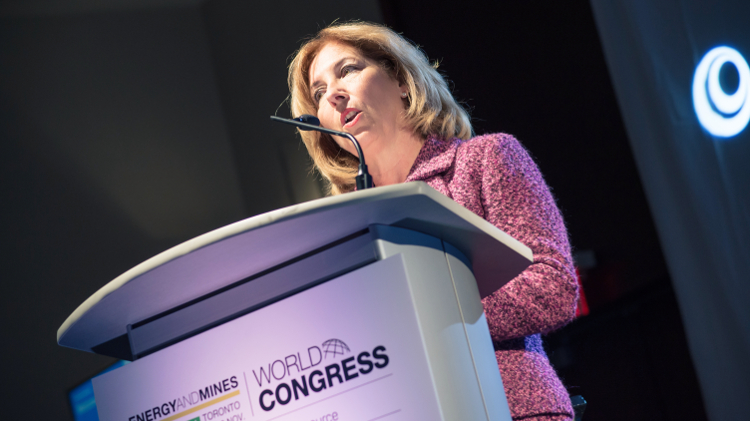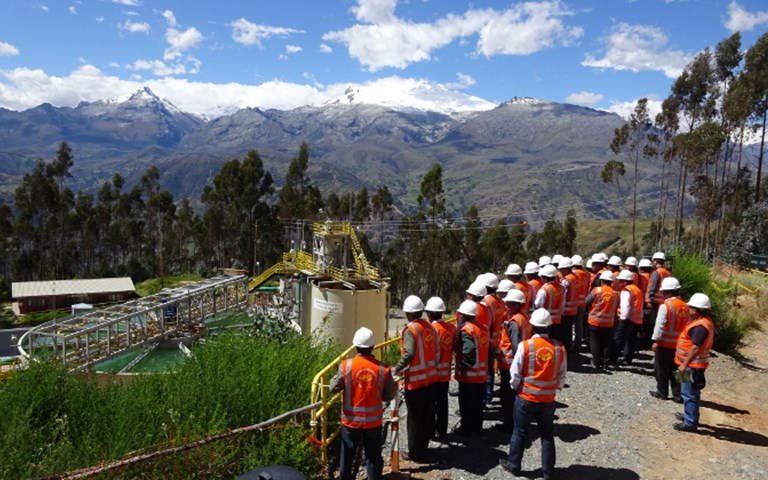A community visit to one of the two water treatment plants at Barrick's Pierina mine in Peru. Courtesy of Barrick Gold
This was one of our favourite stories of the year. To see the full list, check out our Editors' Picks of 2018.
Access to water is a growing global humanitarian and environmental challenge. In the latest World Economic Forum Global Risks Report, water crises ranked fifth in terms of global impact. Competing demands for water will result in food crises, large-scale involuntary migration and environmental degradation. According to the World Bank, 70 per cent of fresh water worldwide is used for agriculture and this sector will need to grow by 50 per cent to feed the expected 10 billion people on earth by 2050.
“The reality is that we all have to learn to live in a resource-constrained world,” said Resa Furey, market analyst at global design and engineering firm Stantec. “Water is life and a finite resource, so limited supplies of fresh water are putting the squeeze on everyone – mining, agriculture and society.”
A reliable water supply is critical to any mining operation. As ore reserves decline, mines are pushed to more remote locations, often in water-stressed countries and regions. A 2014 Moody’s Investor Service report showed that about 70 per cent of mines operated by the “Big Six” – BHP, Rio Tinto, Anglo American, Vale, Xstrata and Glencore – are located in countries where water stress is considered a major risk. Without a robust water management strategy, mining companies are potentially putting their operations, as well as the environment, at risk.
“The most straightforward risk is to lose the social licence to mine, which translates into delays, conflict and bad feelings that do not easily dissipate,” said Jim Finley, a principal geochemist at Stantec who has worked for decades on mine water management projects. “An important component of a mine’s overall risk management program is addressing water supply and use while limiting the impact on existing water users.”
Specific water management solutions are as varied as mines themselves but a trend is emerging. “An often used yet still innovative approach is a ‘fit for use’ water strategy,” said Furey. This approach involves replacing fresh water that would be used in operations with relatively poorer quality water, such as saline groundwater, seawater or wastewater, and treating it so that it is “fit for use” then recycling it through different water management circuits throughout the mine site.
This strategy requires custom, site-specific solutions that involve out-of-the-box thinking and a combination of technical innovation and social collaboration. The hope is to drastically cut water consumption at operations. One company is even going so far as aiming to one day eliminate water withdrawals from the environment.
The road to zero
At an internal sustainability conference in March 2016, Goldcorp president and CEO David Garofalo set a lofty goal for his company, what he called “towards zero water.”
“It took us about a year to wrap our brains around it, to give definition and meaning to it, and start advancing,” said Brendan O’Brien, environment manager at Goldcorp. Later that same year the company launched its Towards Zero Water (H2Zero) water-reduction strategy.
“We’re continually looking for ways to reduce our fresh water usage,” said Michael Jacobs, Goldcorp’s director of water and tailings. “Clearly, we haven’t gotten to the point yet in mining where we can do it without any water, but the objective is to reuse all the water and not add any new water to the system.”
Mines need millions of litres of water each year to process and extract ore, store waste rock as tailings, cool drilling machinery and supress dust. Currently, the largest store of unavailable water in the mining process is locked in conventional slurry tailings but mining companies are becoming more creative about storing tailings in other ways. Goldcorp’s EcoTails project is studying and testing ways to blend coarse waste rock material and finer, filtered tailings together on a giant conveyor system. The two sizes would “co-mingle” and the finer material would fill the gaps between the larger particles to produce strong, stable, solid tailings. Up to 95 per cent of the unavailable water could be recovered and no tailings dam would be required. There may be an additional benefit of reducing the probability or volume of acid rock drainage. Solid tailings like these would result in a smaller mine footprint, lower overall risk and possibly a lower cost over the long term, which includes the closure and post-closure period. Goldcorp began testing the EcoTails concept at its Peñasquito open-pit gold mine in northwest Mexico in 2017.
Related: Derek Chubb of ERM discusses addressing water risks with closure in mind
“We believe EcoTails is the most environmentally and socially responsible method of dealing with tailings,” said Jacobs. “We are also testing this concept at our closed mine in Guatemala with promising results so far.”
EcoTails would require investing in larger and stronger conveyers and equipment, so Goldcorp has collaborated with FLSmidth, which is providing the fast filtering and materials handling equipment for testing. A full-scale prototype is planned at Peñasquito and, depending on the results, could be deployed at the mine.
“We’re in the process now of finalizing the feasibility study for our prototype to launch it,” said Jacobs, “We hope to ultimately roll this out to other Goldcorp properties as well.”
In addition to developing EcoTails, Goldcorp teams are making site-specific modifications at all their operations to dramatically reduce water use. At Peñasquito, a recently installed high-pressure truck washing system collects and reuses 100 per cent of the water used to remove dust, dirt and debris from site vehicles. At Porcupine Gold Mines in Ontario, the amount of fresh water taken from the nearby Porcupine Lake has declined dramatically to 0.1 cubic meters per ounce of gold in 2017, down from 0.35 cubic meters in 2014 after reconfiguring the mill’s water circuit to accept 100 per cent reclaimed water. The Red Lake mine recently implemented a new recycling system on the overflow water from the paste plant to send it back to the mill process water tank, which will allow the mine to displace some of the water supply from Balmer Lake. The Cerro Negro mine also began using a dust suppression agent that will allow them to use less water along a lengthy haul road. And at Musselwhite mine, Goldcorp has installed an underground water recycling plant that uses ultraviolet light to prevent viruses reproducing in recycled water without using chemicals.
Partners in water stewardship
On behalf of its member companies, the International Council on Mining and Metals (ICMM) released a Position Statement on Water Stewardship in January 2017 that defines water stewardship as the use of water in ways that are socially equitable, environmentally sustainable and economically beneficial. Effective stewardship, said ICMM, requires a mining company to collaborate with government, civil society, business and local communities through inclusive stakeholder engagement.
“Technical innovation is fundamental to resolve the challenges of declining access to fresh water in support of mining,” said Stantec’s Finley, “It’s crucial to combine technical innovations with social outreach efforts. While the technical innovation is fundamental to the internal mining operation, winning and maintaining the social licence to mine is critical to the future success of the mining operation.”
On the ground, this translates to companies becoming increasingly creative and clever at finding ways to work with communities, governments and other companies to secure a water supply for the life of the mining operation, recycle as much water as possible on site, and deliver clean water back into the surrounding environment. A unique and successful demonstration of the synergy between social licence and water access is underway at Cerro Verde, Peru’s biggest copper mine, where Freeport-McMoRan built a wastewater treatment plant that would benefit both the operation and the local community of Arequipa.
Researchers from the Canadian International Resources and Development Institute (CIRDI) travelled to Cerro Verde to interview Freeport-McMoRan management, local government and community leaders to document the case as part of its Education and Research for Integrated Water Resources Management in Peru program.
“Freeport didn’t have any means to take water from the river anymore,” said Dr. André Xavier, program manager at CIRDI. “In order to expand, they needed to find different ways to bring in water.”
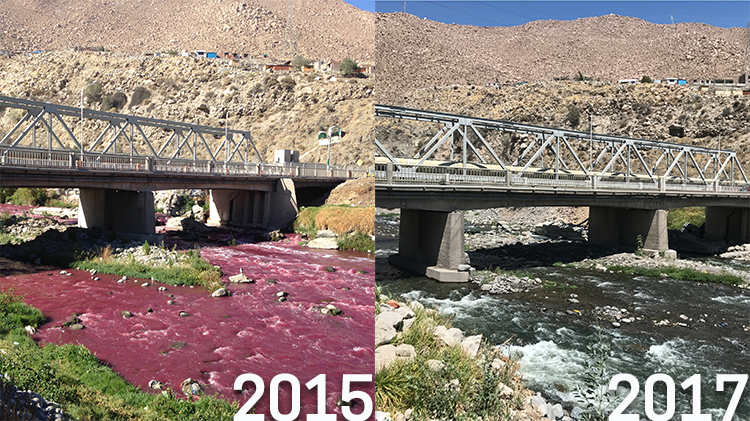 Photos of the same section of the Rio Chili in Peru, taken two years apart. Courtesy of Jose Luis Valverde Ortiz
Photos of the same section of the Rio Chili in Peru, taken two years apart. Courtesy of Jose Luis Valverde Ortiz
One option, explained Xavier, was to invest in constructing over 100 kilometers of pipelines and numerous pumping and water treatment stations to push seawater up 2,500 metres and over mountainous terrain from the coast. Although other operations, such as Minera Esperanza’s copper-gold operation in Chile, successfully use untreated seawater in the processing plant, this expensive option was rejected.
The creative solution at Cerro Verde came instead from the community, which suggested the mine use treated wastewater for mining operations. After seven years of negotiations and planning, the wastewater treatment plant was commissioned in late 2015 and now treats 85 per cent of Arequipa’s municipal sewage. The mine takes just over half of the 1.8 cubic metres per second of treated wastewater produced by the plant for mining operations and what remains is discharged into the Rio Chili, which provides 95 per cent of the area’s municipal and agricultural water needs.
In exchange for building, operating and maintaining the plant, Freeport-McMoRan not only secured a water source for the expanding Cerro Verde mine, but a continuing social licence to operate. In the CIRDI case study, Fraser points out that, “Unlike other projects in the region, Cerro Verde did not experience any lost production due to community opposition.” Although Cerro Verde and Southern Copper’s Tia Maria mine are just 90 km apart, Tia Maria has faced prolonged opposition from local people over concerns about water contamination and were unable to get a permit to operate for several years.
Putting data to work
Freeport-McMoRan’s willingness to listen and engage with the surrounding communities and invest in building shared infrastructure is an important reminder that mines don’t stand alone. Mines are both integrated residents in society and just a tiny dot on the map in the wider water basin. Barrick Gold recognizes this and is taking a “basin stewardship approach” to water management, communicating its activities to the communities they work in through fair and early engagement.
“Transparency is the currency of trust,” said John McCartney, vice-president of water management at Barrick. “It’s about making sure that all of our activities are very well known to everybody, and they are able to participate as much as they can in the decisions that we make.”
Barrick is making the effort to go beyond simply disclosing data in sustainability reports and making it “easier to access, more visible and more interactive so that people can actually see how we’re doing.” Within two clicks of the home page, any stakeholder or member of the public can access interactive water use graphs and download spreadsheets of detailed water management data for any of Barrick’s operations worldwide.
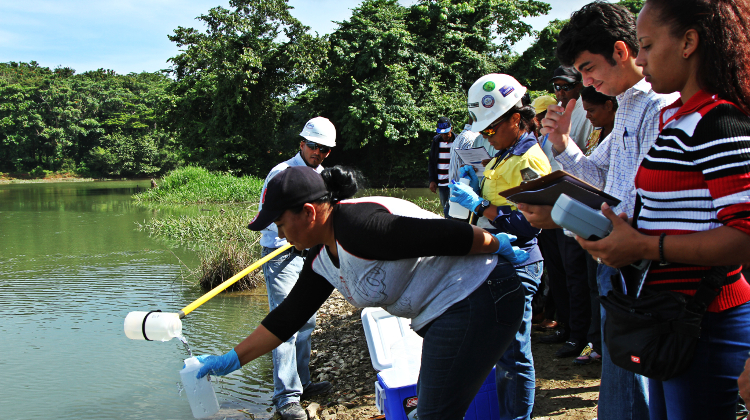 Local communities participate in downstream monitoring of the Margajita River, which runs adjacent to Barrick's Pueblo Viejo mine in the Dominican Republic. Community members collect water samples to be analyzed at independently certified laboratories. Courtesy of Barrick Gold
Local communities participate in downstream monitoring of the Margajita River, which runs adjacent to Barrick's Pueblo Viejo mine in the Dominican Republic. Community members collect water samples to be analyzed at independently certified laboratories. Courtesy of Barrick Gold
In addition to this increased distribution of data, Barrick is also putting its data to work by applying machine learning to help predict water issues. “Extreme drought can affect our water supply, for example,” said McCartney. “We’ve started a program of implementing continuous online water balances fed by continuous weather updates for particular facilities to look at what their risk level is for those facilities.”
Barrick has built a Consolidated Data Platform to connect the databases storing reams of critical information collected at mines and offices around the world. This digital conduit provides a platform to quickly access and share data, which can then be plugged into machine learning algorithms to monitor and predict water usage, mine processing and productivity, among other things.
“Using new machine learning we would be able to track and look at those patterns and trends to see if we have emerging risks,” said McCartney.
Water out
One of the biggest risks related to water management at mine sites is the unplanned release of untreated water into surrounding waterways. In January, Nevada-based Tahoe Resources responded to an alleged spill at the Shahuindo mine in central Peru, where heavy rains caused a diversion ditch to overflow. News outlets were quick to report the spill and the company responded with a press release detailing the incident and the inspection by local authorities.
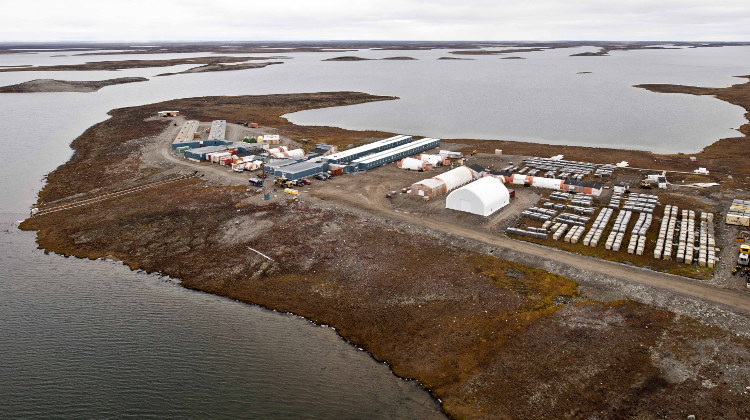 Aerial shot of Agnico Eagle's Medliadine mine in Nunavut. Courtesy of Agnico Eagle
Aerial shot of Agnico Eagle's Medliadine mine in Nunavut. Courtesy of Agnico Eagle
The scrutiny of water use is not confined to arid or densely populated areas. Near the western shore of Hudson Bay in the Kivalliq region of Nunavut, Agnico Eagle’s high-grade Meliadine gold mine is currently under construction and also under the microscope. In 2016, Agnico Eagle received a water licence from the Nunavut Water Board to begin construction activities at the planned mine site.
“Water quality in Nunavut is very important because it’s a pristine environment,” said Michel Julien, Agnico Eagle’s vice-president of environment. “Water is a resource and it should be protected like any other resource. What we need to do is approach it in a reasonable and responsible manner. We try to limit external water usage as much as we can, so it forces us to use technologies that promote recycling and reuse of water.”
Related: After Mount Polley, miners and engineers grapple with the risk of maintaining the status quo
Agnico Eagle plans to use filtered tailings at Meliadine once the project, currently under construction, begins production in 2019. All the excess process water will be recirculated through the filtration plant, Julien explained, which is more complicated operationally but will greatly reduce the amount of water managed at the surface. Agnico Eagle is also looking into technologies to manage salinity at Meliadine to prevent water with high salinity being released into the environment.
Julien acknowledged that these engineering solutions require additional effort and capital investment to improve water management at Meliadine, but the reward is in risk reduction. “When there are issues,” said Julien, “it’s often related to water.”

